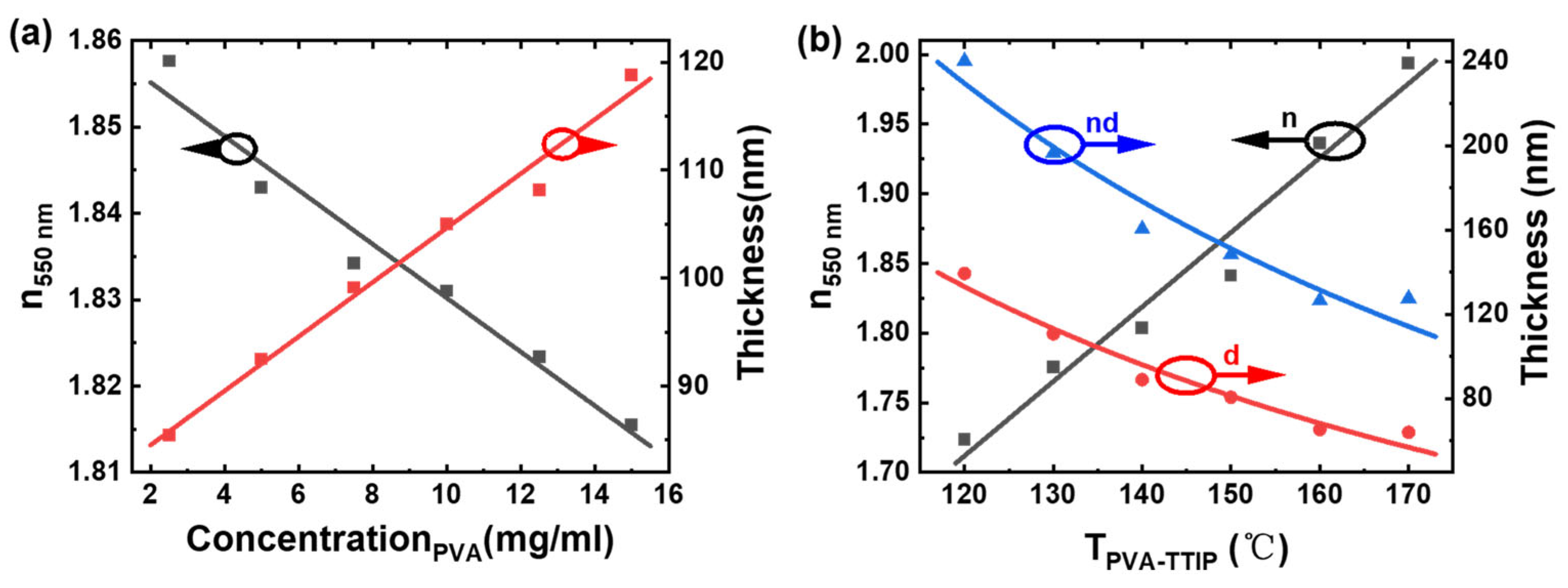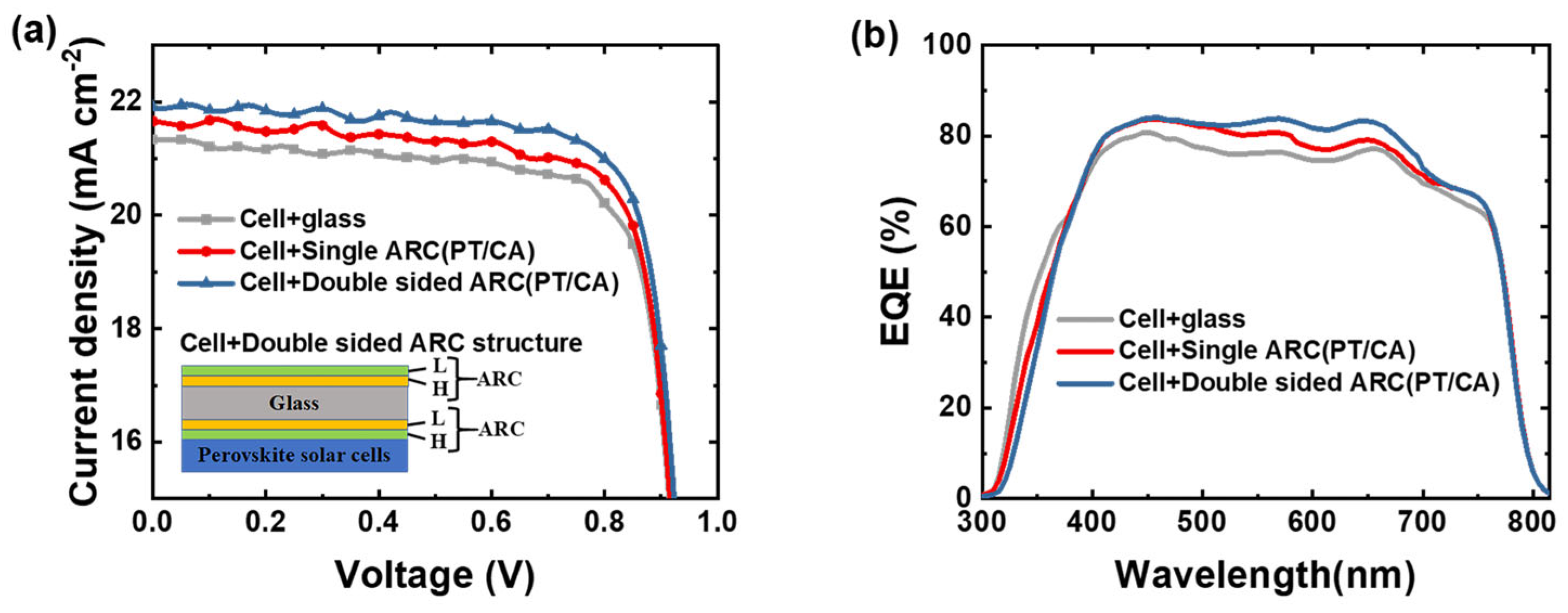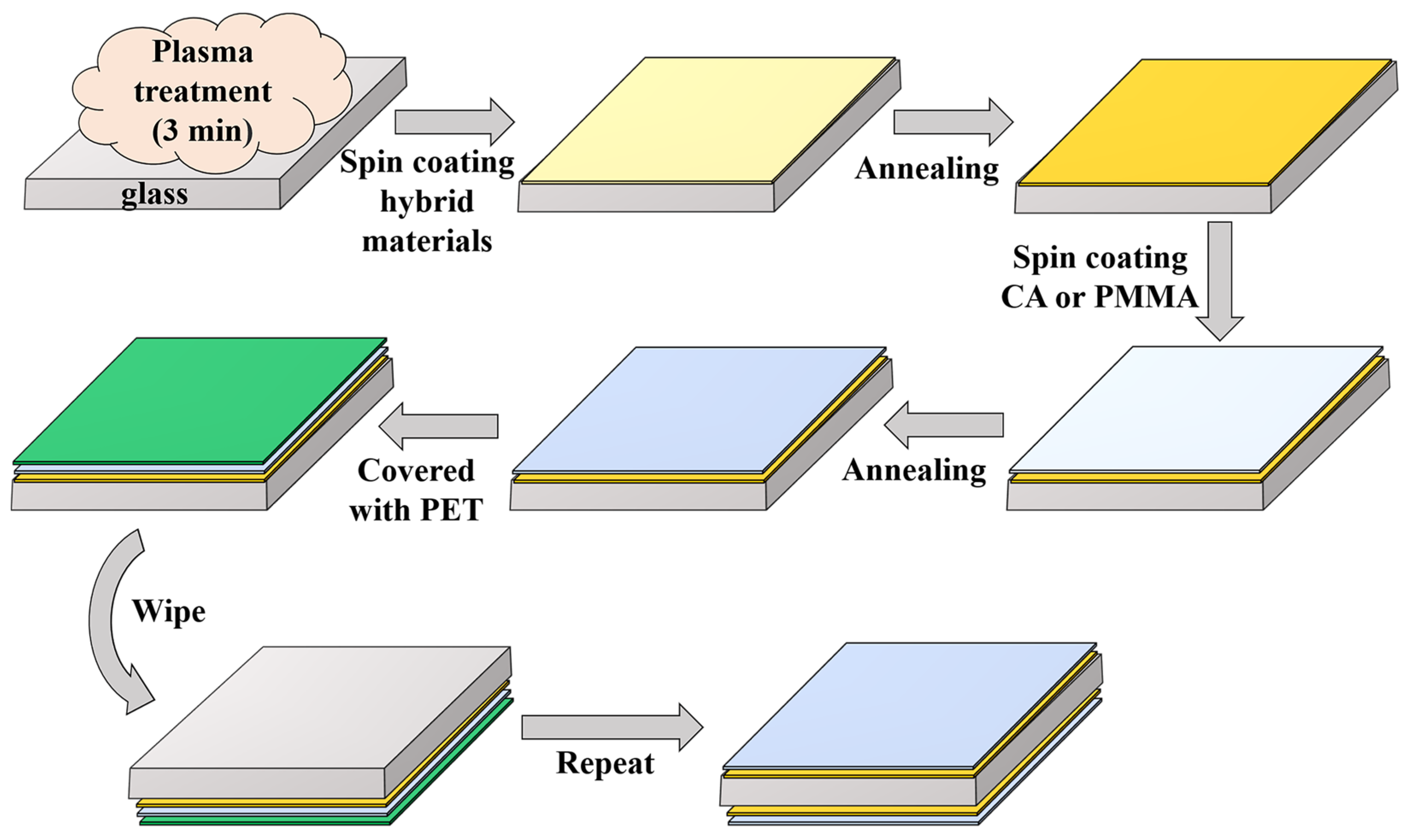Solution-Processed Large-Area Organic/Inorganic Hybrid Antireflective Films for Perovskite Solar Cell
Abstract
:1. Introduction
2. Results and Discussion
2.1. Theoretical Simulations of the Antireflective Films
2.2. Chemical Properties of the Hybrid Material
2.3. Optical Properties of the Hybrid Materials
2.4. Preparation of the Antireflective Films
2.5. Application to Photovoltaic Modules
3. Materials and Methods
3.1. Materials
3.2. Preparation of Thin Films and Solutions
3.3. Morphology and Optical Characterization
3.4. Fabrication and Characterization of Perovskite Solar Cells
4. Conclusions
Supplementary Materials
Author Contributions
Funding
Institutional Review Board Statement
Informed Consent Statement
Data Availability Statement
Conflicts of Interest
References
- Caseri, W. Nanocomposites of polymers and inorganic particles: Preparation, structure and properties. Mater. Sci. Technol. 2006, 22, 807–817. [Google Scholar] [CrossRef]
- Judeinstein, P.; Sanchez, C. Hybrid organic–inorganic materials: A land of multidisciplinarity. J. Mater. Chem. 1996, 6, 511–525. [Google Scholar] [CrossRef]
- Zvonkina, I.; Soucek, M. Inorganic–organic hybrid coatings: Common and new approaches. Curr. Opin. Chem. Eng. 2016, 11, 123–127. [Google Scholar] [CrossRef]
- Currie, M.J.; Mapel, J.K.; Heidel, T.D.; Goffri, S.; Baldo, M.A. High-efficiency organic solar concentrators for photovoltaics. Science 2008, 321, 226–228. [Google Scholar] [CrossRef] [PubMed]
- Kobrinski, H.; Cheung, K.-W. Wavelength-tunable optical filters: Applications and technologies. IEEE Commun. Mag. 1989, 27, 53–63. [Google Scholar] [CrossRef]
- Ting, C.-J.; Huang, M.-C.; Tsai, H.-Y.; Chou, C.-P.; Fu, C.-C. Low cost fabrication of the large-area anti-reflection films from polymer by nanoimprint/hot-embossing technology. Nanotechnology 2008, 19, 205301. [Google Scholar] [CrossRef] [Green Version]
- Choi, K.; Park, S.H.; Song, Y.M.; Lee, Y.T.; Hwangbo, C.K.; Yang, H.; Lee, H.S. Nano-tailoring the surface structure for the monolithic high-performance antireflection polymer film. Adv. Mater. 2010, 22, 3713–3718. [Google Scholar] [CrossRef]
- Huh, D.; Choi, H.-J.; Byun, M.; Kim, K.; Lee, H. Long-term analysis of PV module with large-area patterned anti-reflective film. Renew. Energy 2019, 135, 525–528. [Google Scholar] [CrossRef]
- Zambrano-Mera, D.F.; Espinoza-González, R.; Villarroel, R.; Rosenkranz, A.; Carvajal, N.; Pintor-Monroy, M.I.; Montaño-Figueroa, A.G.; Arellano-Jiménez, M.J.; Quevedo-López, M.; Valenzuela, P. Optical and mechanical properties of Zr-oxide doped TiO2/SiO2 anti-reflective coatings for PV glass covers. Sol. Energy Mater. Sol. Cells 2022, 243, 111784. [Google Scholar] [CrossRef]
- Amruth, C.; Dubey, D.K.; Pahlevani, M.; Welch, G.C. Slot-Die Coating of All Organic/Polymer Layers for Large-Area Flexible OLEDs: Improved Device Performance with Interlayer Modification. Adv. Mater. Technol. 2021, 6, 2100264. [Google Scholar]
- Garlisi, C.; Trepci, E.; Li, X.; Al Sakkaf, R.; Al-Ali, K.; Nogueira, R.P.; Zheng, L.; Azar, E.; Palmisano, G. Multilayer thin film structures for multifunctional glass: Self-cleaning, antireflective and energy-saving properties. Appl. Energy 2020, 264, 114697. [Google Scholar] [CrossRef]
- Yu, Y.-Y.; Chien, W.-C.; Lin, J.M.; Yu, H.-H. High transparent polyimide/titania multi-layer anti-reflective hybrid films. Thin Solid Film. 2011, 519, 4731–4736. [Google Scholar] [CrossRef]
- Russo, M. Titanium Oxide Hydrates: Optical Properties and Applications; Queen Mary University of London: London, UK, 2010. [Google Scholar]
- Bachevillier, S. Solution-Processed Photonics for Light and Heat Management; Imperial College London: London, UK, 2019. [Google Scholar]
- Hu, Y.; Huang, J.-s.; Stavrinou, P.N.; Bradley, D.D. Light Regulation of Organic Light-Emitting Diodes with Conductive Distributed Bragg Reflectors, Optoelectronic Devices and Integration XI. SPIE Digital Library 2022, 74–82. [Google Scholar] [CrossRef]
- Russo, M.; Campoy-Quiles, M.; Lacharmoise, P.; Ferenczi, T.A.; Garriga, M.; Caseri, W.R.; Stingelin, N. One-pot synthesis of polymer/inorganic hybrids: Toward readily accessible, low-loss, and highly tunable refractive index materials and patterns. J. Polym. Sci. Part B Polym. Phys. 2012, 50, 65–74. [Google Scholar] [CrossRef]
- Votta, I. Titanium-Oxide-Hydrates Based Organic/Inorganic Molecular Hybrids Produced via Sol-Gel Processing; Imperial College London: London, UK, 2017. [Google Scholar]
- Attar, A.S.; Ghamsari, M.S.; Hajiesmaeilbaigi, F.; Mirdamadi, S. Modifier ligands effects on the synthesized TiO2 nanocrystals. J. Mater. Sci. 2008, 43, 1723–1729. [Google Scholar] [CrossRef]
- Okunaka, S.; Tokudome, H.; Hitomi, Y.; Abe, R. Facile preparation of stable aqueous titania sols for fabrication of highly active TiO2 photocatalyst films. J. Mater. Chem. A 2015, 3, 1688–1695. [Google Scholar] [CrossRef]
- Li, Y.; Ji, C.; Qu, Y.; Huang, X.; Hou, S.; Li, C.Z.; Liao, L.S.; Guo, L.J.; Forrest, S.R. Enhanced light utilization in semitransparent organic photovoltaics using an optical outcoupling architecture. Adv. Mater. 2019, 31, 1903173. [Google Scholar] [CrossRef]
- Byranvand, M.M.; Behboodi-Sadabad, F.; Eliwi, A.A.; Trouillet, V.; Welle, A.; Ternes, S.; Hossain, I.M.; Khan, M.R.; Schwenzer, J.A.; Farooq, A. Chemical vapor deposited polymer layer for efficient passivation of planar perovskite solar cells. J. Mater. Chem. A 2020, 8, 20122–20132. [Google Scholar] [CrossRef]
- Schmager, R.; Roger, J.; Schwenzer, J.A.; Schackmar, F.; Abzieher, T.; Malekshahi Byranvand, M.; Abdollahi Nejand, B.; Worgull, M.; Richards, B.S.; Paetzold, U.W. Laminated perovskite photovoltaics: Enabling novel layer combinations and device architectures. Adv. Funct. Mater. 2020, 30, 1907481. [Google Scholar] [CrossRef]
- Miao, L.; Su, L.F.; Tanemura, S.; Fisher, C.A.; Zhao, L.L.; Liang, Q.; Xu, G. Cost-effective nanoporous SiO2–TiO2 coatings on glass substrates with antireflective and self-cleaning properties. Appl. Energy 2013, 112, 1198–1205. [Google Scholar] [CrossRef]
- Nakamoto, K. Infrared and Raman Spectra of Inorganic and Coordination Compounds, Part B: Applications in Coordination, Organometallic, and Bioinorganic Chemistry; John Wiley & Sons: Hoboken, NJ, USA, 2009. [Google Scholar]
- Stambolova, I.; Blaskov, V.; Kuznetsova, I.; Kostova, N.; Vassilev, S. Effect of the thermal treatment on the morphology and optical properties of nanosized TiO2 films. J. Optoelectron. Adv. Mater. 2011, 13, 381. [Google Scholar]
- Bachevillier, S.; Yuan, H.K.; Strang, A.; Levitsky, A.; Frey, G.L.; Hafner, A.; Bradley, D.D.; Stavrinou, P.N.; Stingelin, N. Fully Solution-Processed Photonic Structures from Inorganic/Organic Molecular Hybrid Materials and Commodity Polymers. Adv. Funct. Mater. 2019, 29, 1808152. [Google Scholar] [CrossRef]
- Boyd, R.W.; Gehr, R.J.; Fischer, G.L.; Sipe, J. Nonlinear optical properties of nanocomposite materials. Pure Appl. Opt. J. Eur. Opt. Soc. Part A 1996, 5, 505. [Google Scholar] [CrossRef]
- Webb, H.K.; Truong, V.K.; Hasan, J.; Fluke, C.; Crawford, R.J.; Ivanova, E.P. Roughness parameters for standard description of surface nanoarchitecture. Scanning 2012, 34, 257–263. [Google Scholar] [CrossRef] [PubMed] [Green Version]
- Yu, C.; Hu, Y.; Yang, J.; Huang, J.; Li, B.; Wu, L.; Li, F. Efficient and Stable Inverted Perovskite Solar Cells with TOASiW12-Modified Al as a Cathode. Adv. Funct. Mater. 2022, 33, 2209290. [Google Scholar] [CrossRef]






| Perovskite Solar Cell | JSC (mA/cm2) | JSC (EQE) (mA/cm2) a | FF (%) | VOC (V) | PCE (%) |
|---|---|---|---|---|---|
| With bare glass | 21.32 | 18.91 | 79.91 | 0.97 | 16.57 |
| With a single ARC (PT/CA) | 21.66 | 19.68 | 79.99 | 0.97 | 16.85 |
| With double-sided ARC (PT/CA) | 21.92 | 20.02 | 80.35 | 0.98 | 17.25 |
Disclaimer/Publisher’s Note: The statements, opinions and data contained in all publications are solely those of the individual author(s) and contributor(s) and not of MDPI and/or the editor(s). MDPI and/or the editor(s) disclaim responsibility for any injury to people or property resulting from any ideas, methods, instructions or products referred to in the content. |
© 2023 by the authors. Licensee MDPI, Basel, Switzerland. This article is an open access article distributed under the terms and conditions of the Creative Commons Attribution (CC BY) license (https://creativecommons.org/licenses/by/4.0/).
Share and Cite
Huo, M.; Hu, Y.; Xue, Q.; Huang, J.; Xie, G. Solution-Processed Large-Area Organic/Inorganic Hybrid Antireflective Films for Perovskite Solar Cell. Molecules 2023, 28, 2145. https://doi.org/10.3390/molecules28052145
Huo M, Hu Y, Xue Q, Huang J, Xie G. Solution-Processed Large-Area Organic/Inorganic Hybrid Antireflective Films for Perovskite Solar Cell. Molecules. 2023; 28(5):2145. https://doi.org/10.3390/molecules28052145
Chicago/Turabian StyleHuo, Mingfang, Yun Hu, Qin Xue, Jingsong Huang, and Guohua Xie. 2023. "Solution-Processed Large-Area Organic/Inorganic Hybrid Antireflective Films for Perovskite Solar Cell" Molecules 28, no. 5: 2145. https://doi.org/10.3390/molecules28052145






